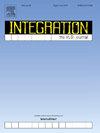An efficient numerical simulation method based on practical 1T1R devices measurement for compute in memory chip design
IF 2.2
3区 工程技术
Q3 COMPUTER SCIENCE, HARDWARE & ARCHITECTURE
引用次数: 0
Abstract
As compute-in-memory (CIM) architecture emerge to overcome the Von Neumann bottleneck, the efficient simulation of its core one-transistor-one-resistor (1T1R) crossbar array becomes critical.
Due to the compact nonlinear voltage division, the simulation efficiency of existing methods is hard to meet the simulation speed requirement of CIM chip design. Therefore, a novel numerical algorithm called dichotomy voltage division method (DVDM) was proposed. DVDM leverages interval bisection to bypass derivative calculations, achieving over 30 % speedup than the netlist-based Hspice method and 103-fold acceleration than the Matlab symbolic calculation method for DC scanning simulation. Crucially, DVDM's efficiency does not compromise fidelity to established compact models, which maintains equivalent accuracy to these established methods. Furthermore, DVDM successfully simulates the multiply accumulate operations—a cornerstone of neural network inference—demonstrating its potential to bridge device-level modeling and system-level CIM chip design. By balancing computational efficiency with model fidelity, DVDM provides a novel tool for rapid exploration of next-generation CIM systems.
一种基于实际1T1R器件测量的有效数值模拟方法,适用于存储芯片设计计算
随着内存计算(CIM)架构的出现,其核心一晶体管一电阻(1T1R)交叉阵列的高效仿真成为突破冯-诺依曼瓶颈的关键。因此,一种名为二分法电压划分法(DVDM)的新型数值算法被提出。DVDM 利用区间分段绕过导数计算,在直流扫描仿真中比基于网表的 Hspice 方法提高了 30% 以上的速度,比 Matlab 符号计算方法提高了 103 倍。最重要的是,DVDM 的效率并不影响对已建立的紧凑模型的保真度,其精度与这些已建立的方法相当。此外,DVDM 还成功模拟了神经网络推理的基石--乘法累加运算,证明了它在设备级建模和系统级 CIM 芯片设计之间架起桥梁的潜力。通过平衡计算效率和模型保真度,DVDM 为快速探索下一代 CIM 系统提供了一种新颖的工具。
本文章由计算机程序翻译,如有差异,请以英文原文为准。
求助全文
约1分钟内获得全文
求助全文
来源期刊

Integration-The Vlsi Journal
工程技术-工程:电子与电气
CiteScore
3.80
自引率
5.30%
发文量
107
审稿时长
6 months
期刊介绍:
Integration''s aim is to cover every aspect of the VLSI area, with an emphasis on cross-fertilization between various fields of science, and the design, verification, test and applications of integrated circuits and systems, as well as closely related topics in process and device technologies. Individual issues will feature peer-reviewed tutorials and articles as well as reviews of recent publications. The intended coverage of the journal can be assessed by examining the following (non-exclusive) list of topics:
Specification methods and languages; Analog/Digital Integrated Circuits and Systems; VLSI architectures; Algorithms, methods and tools for modeling, simulation, synthesis and verification of integrated circuits and systems of any complexity; Embedded systems; High-level synthesis for VLSI systems; Logic synthesis and finite automata; Testing, design-for-test and test generation algorithms; Physical design; Formal verification; Algorithms implemented in VLSI systems; Systems engineering; Heterogeneous systems.
 求助内容:
求助内容: 应助结果提醒方式:
应助结果提醒方式:


